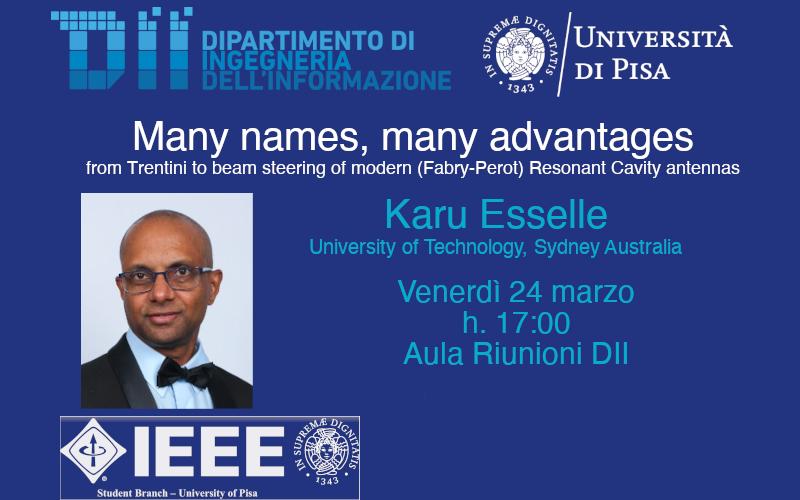La nomina a Distinguished Contributor (DC) premia i membri e gli affiliati della Computer Society che hanno apportato contributi tecnici significativi e continuativi alla IEEE Computer Society, alla...
Leggi tuttoMany names, many advantages – from Trentini to beam steering of modern (Fabry-Perot) Resonant Cavity antennas

Aula Riunioni DII
Via Caruso 16 Pisa - Piano Terra
Abstract
No other antenna concept has more names. At present these antennas are known as Fabry-Perot resonant cavity antennas, just Resonant Cavity Antennas (RCA), Partial Reflector Surface (PRS) based antennas, Electromagnetic Band Gap (EBG) Resonator antennas (ERAs) and Two-Dimensional Leaky- Wave Antennas, and more names are forthcoming. Yet they all have more or less the same configuration consisting of a resonant cavity, formed between a partially reflecting superstructure and a fully reflecting (ground) plane. The resonant cavity is excited by a small feed antenna. Hence, they are referred to as resonant cavity antennas (RCAs) in this presentation. Since the concept of using a “partially reflecting sheet array” superstructure to significantly enhance the directivity was disclosed by Trentini in 1956, it has been an attractive concept to several antenna researchers for several reasons, including its theoretical elegance, relationships to other well-researched area such as leaky-waves, EBG, frequency selective surfaces and metasurfaces, and practical advantages as a low-cost simple way to achieve high-gain (15-25 dBi) from an efficient planar antenna without an array, which requires a feed network. The RCA concept is one of the main beneficiaries of the surge of research on electromagnetic periodic structures in the last decade, first inspired by EBG and then to some extent by metamaterials. As a result, RCAs gained a tremendous improvement in performance in the last 10 years, in addition to other advantages such as size reduction. As an example, achieving 10% gain bandwidth from such an antenna with a PSS was a major breakthrough in 2006 but now there are prototypes with gain bandwidths greater than 50%. Until recently most RCAs required an area in the range of 25-100 square wavelengths but the latest extremely wideband RCAs are very compact, requiring only 1.5-2 square wavelengths at the lowest operating frequency.
Once limited to a select group of researchers, these advantages have attracted many new researchers to RCA research domain, and the list is growing fast, as demonstrated by the diversity of authors in recent RCA publications. RCAs have already replaced other types of antennas, for example as feeds for reflectors.
This presentation will take the audience through historical achievements of RCA technology, giving emphasis to breakthroughs in the last 20 years up to a recent method of steering its beam continuously in 2D (i.e., azimuth and elevation).
Bio
Karu Esselle, is the Distinguished Professor in Electromagnetic and Antenna Engineering at the University of Technology Sydney and a Visiting Professor of Macquarie University, Sydney. Karu is Australia’s 2022 Professional Engineer of the Year and a Fellow of the Royal Society of New South Wales, IEEE and Engineers Australia, and a Director of Innovations for Humanity Pty Ltd.
Karu’s other most recent awards include the top Space award in Australia – the “Winner of Winners” Excellence Award – as well as the Academic of Year Award at the 2022 Australian Space Awards, Engineers Australia 2022 Sydney Professional Engineer of the Year and Bradfield Awards (in addition to the national title mentioned previously), both the most prestigious Excellence Award and the Academic of the Year Award at 2021 Australian Defence Industry Awards, Finalist for 2021 Australian national Eureka Prize for Outstanding Mentor of Young Researchers, Runner-up to the same prize in 2020, 2019 Motohisa Kanda Award for the most cited paper in IEEE Transactions on EMC in the past five years, 2021 IEEE Asia-Pacific Outstanding Volunteer Award. he is the 2019 National Research Field Leader in Australia in both Microelectronics and Electromagnetism fields.
Karu has authored over 650 research publications and his papers have been cited over 13,000 times.
Since 2002, his research team has been involved with research grants, contracts worth over 25 million dollars.
Karu has provided expert assistance to more than a dozen companies including Intel, Hewlett Packard (USA), Cisco Systems (USA. His led the team that designed the high- gain antenna system for the world’s first entirely Ka-band CubeSat made by Audacy, USA and launched to space by SpaceX in December 2018. This is believed to be the first Australian-designed high-gain antenna system launched to space, since CSIRO-designed antennas in Australia’s own FedSat launched in 2002.



